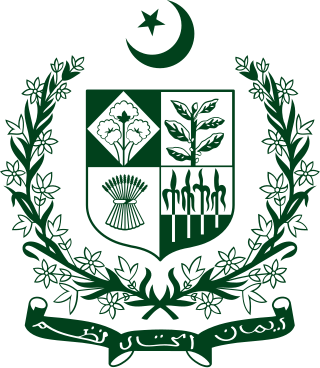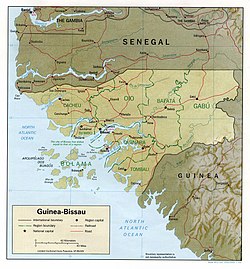
Freedom of religion in Pakistan is formally guaranteed by the Constitution of Pakistan for individuals of various religions and religious sects.

Freedom of religion in Afghanistan changed during the Islamic Republic installed in 2002 following a U.S.-led invasion that displaced the former Taliban government.

Islam is the major religion in the Gambia, representing 97% of the 2 million population, with the first Muslim communities in the country arriving in 11th century. Islam has therefore had an influence on the Gambia throughout history, and continues to impact its culture, society and politics. The majority of The Gambia's Muslims are Sunni belonging to the Maliki school of jurisprudence, influenced with Sufism. There is a smaller Shiite community, largely stemming from Lebanese and Arab migration. The Ahmadiyya movement is also present. Other religious societies exist in the country, including Catholics, Protestants, Hindus and Traditional African religions.

The situation of human rights in Pakistan is complex as a result of the country's diversity, large population, its status as a developing country and a sovereign Islamic democracy with a mixture of both Islamic and secular law.

Islam in Guinea-Bissau is the nation's second largest religion behind Christianity. As of 2019, an estimated 36% of its roughly 2 million citizens are Muslims. Some estimates put this at a higher figure.

The Ahmadiyya branch of Islam has been subjected to various forms of religious persecution and discrimination since the movement's inception in 1889. The Ahmadiyya Muslim movement emerged within the Sunni tradition of Islam and its adherents believe in all of the five pillars and all of the articles of faith required of Muslims. Ahmadis are considered non-Muslims by many mainstream Muslims since they consider Mirza Ghulam Ahmad, the founder of the movement, to be the promised Mahdi and Messiah awaited by the Muslims.
The Constitution of Bangladesh includes secularism as one of the four fundamental principles, despite having Islam as the state religion by 2A. Islam is referred to twice in the introduction and Part I of the constitution and the document begins with the Islamic phrase Basmala which in English is translated as “In the name of Allah, the Beneficent, the Merciful” and article (2A) declares that :"Islam is the state religion of the republic". Bangladesh is mostly governed by secular laws, set up during the times when the region was ruled by the British Crown.
The Indonesian constitution provides some degree of freedom of religion. The government generally respects religious freedom for the six officially recognized religions and/or folk religion. All religions have equal rights according to the Indonesian laws.

Ahmadiyya is an Islamic branch in Switzerland, under the spiritual leadership of the caliph in London. The Community was founded on October 13, 1946, during the late period of the Second Caliphate, when the caliph directed Shaikh Nasir Ahmad to establish a mission in the country. Today there are two Ahmadi mosques and 14 local branches, representing an estimated 800 Ahmadi Muslims.

Ahmadiyya, officially the Ahmadiyya Muslim Jama'at (AMJ) is an Islamic messianic movement originating in British India in the late 19th century. It was founded by Mirza Ghulam Ahmad (1835–1908), who said he had been divinely appointed as both the Promised Mahdi and Messiah expected by Muslims to appear towards the end times and bring about, by peaceful means, the final triumph of Islam; as well as to embody, in this capacity, the expected eschatological figure of other major religious traditions. Adherents of the Ahmadiyya—a term adopted expressly in reference to Muhammad's alternative name Ahmad—are known as Ahmadi Muslims or simply Ahmadis.

Ahmadiyya is an Islamic branch in Indonesia. The earliest history of the community in Indonesia dates back to the early days of the Second Caliph. During the summer of 1925, roughly two decades prior to the Indonesian revolution, a missionary of the Community, Rahmat Ali, stepped on Indonesia's largest island Sumatra. He established the movement with 13 devotees in Tapaktuan, in the province of Aceh. The Community has an influential history in Indonesia's religious development,. However, in the modern times it has faced increasing intolerance from religious establishments in the country and physical hostilities from radical Muslim groups. The Association of Religion Data Archives estimates around 400,000 Ahmadi Muslims, spread over 542 branches across the country.

Ahmadiyya in Pakistan are members of the Ahmadiyya Community. The number of Ahmadiyya in the country has been variously estimated to between 0.22% and 2.2% of Pakistan's population. Hence, Pakistan is the home to the largest population of Ahmadis in the world. The city of Rabwah in the province of Punjab used to be the global headquarters of the Ahmadiyya Community before they were moved to England.

The Ahmadiyya Muslim Community is the second-largest sect of Islam in Sierra Leone, behind only Sunni Islam. The earliest history of the Community in Sierra Leone dates back to the early period of the Second Caliphate, when at least six people are said to have conveyed their adherence to the faith. The sect attained rapid growth in the country after the 1937 arrival of Nazir Ahmad Ali, the first permanent Ahmadi missionary in Sierra Leone. Recent estimates by Ahmadi community suggest that there are approximately 560,000 Ahmadi Muslims in Sierra Leone, which is about 9% of the country's total population. Sierra Leone has the largest percentage of Ahmadi Muslims by share of total population in the world.

Ahmadiyya is an Islamic religious movement originating in 1889 in northern India around the teachings of Mirza Ghulam Ahmad (1835–1908), who claimed to have been divinely appointed as both the promised Mahdi and Messiah expected by Muslims to appear towards the end times.

Ahmadiyya is a persecuted religion in Saudi Arabia. Although there are many foreign workers and Saudi citizens belonging to the Ahmadiyya movement in Saudi Arabia, Ahmadis are officially banned from entering the country and from performing the pilgrimage to Mecca and Medina. This has led to criticisms from multiple human rights organizations.

Ahmadiyya is an Islamic branch in the United States. The earliest contact between the American people and the Ahmadiyya movement in Islam was during the lifetime of Mirza Ghulam Ahmad. In 1911, during the era of the First Caliphate of the Community, the Ahmadiyya movement in India began to prepare for its mission to the United States. However, it was not until 1920, during the era of the Second Caliphate of the Ahmadiyya movement, that Mufti Muhammad Sadiq, under the directive of the caliph, would leave England on SS Haverford for the United States. Sadiq established the Ahmadiyya Muslim Community in the United States in 1920. The U.S. Ahmadiyya movement is considered by some historians as one of the precursors to the Civil Rights Movement in America. The Community was the most influential Muslim community in African-American Islam until the 1950s. Today, there are approximately 15,000 to 20,000 American Ahmadi Muslims spread across the country.

Ahmadiyya in The Gambia is part of the worldwide Ahmadiyya Muslim Jama'at under the leadership of the Ahmadiyya Caliphate. Ahmadiyya teachings entered Gambia during the era of the Second Caliphate through the flow of Ahmadiyya literature and a number of traders returning to the country. The first missionary to enter the country was Alhaji Hamza Sanyaolo, a Nigerian who entered in 1959. After a number of months he was followed by Gibriel Saeed, a Ghanaian missionary. Since its earliest history in the Gambia, the community has been facing resistance and religious intolerance from certain Muslim clerics and Islamic bodies in the country.

The Ahmadiyya Muslim Community is the second largest group of Islam in Ghana after Sunni Islam. The early rise of the Community in Ghana can be traced through a sequence of events beginning roughly at the same time as the birth of the Ahmadiyya movement in 1889 in British India. It was during the early period of the Second Caliphate that the first missionary, Abdul Rahim Nayyar was sent to what was then the Gold Coast in 1921 upon invitation from Sunni Muslims in Saltpond. Having established the movement in the country, Nayyar left and was replaced by the first permanent missionary, Al Hajj Fadl-ul-Rahman Hakim in 1922.

Ahmadiyya is an Islamic community in Kyrgyzstan, whose teachings were first brought into the country by foreign Pakistani missionaries in the early 1990s. Although the Community was first registered in the country in 2002, its registration was struck off with the country's State Commission on Religious Affairs refusing to re-register it in 2011. Today, the Community which faces religious persecution, represents up to 1000 members spread across the capital Bishkek and three other regions of the country.
The status of religious freedom in Africa varies from country to country. States can differ based on whether or not they guarantee equal treatment under law for followers of different religions, whether they establish a state religion, the extent to which religious organizations operating within the country are policed, and the extent to which religious law is used as a basis for the country's legal code.







